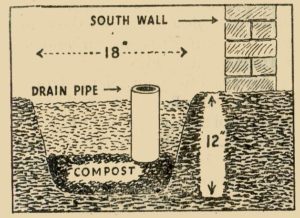To grow tomatoes successfully in the open you must have a good site. The best spot would be in the shelter of a wall or fence facing south or south-west, because there the temperature won’t fall too low at night. The plants will get some sunshine there and be protected from the cold east winds we often get early in June.
 Get the ground ready well in advance of planting. Take out a trench 9 to 12 in. deep and 15 to 18 in. wide and dig in compost or well-rotted manure into the second spit. For watering during summer get some unglazed drainpipes, if you can, and put them upright into the trench, 3 ft. apart. Then fill up the trench with the soil you took out. These pipes will let the water get to the subsoil, which it is difficult to wet by surface watering.
Get the ground ready well in advance of planting. Take out a trench 9 to 12 in. deep and 15 to 18 in. wide and dig in compost or well-rotted manure into the second spit. For watering during summer get some unglazed drainpipes, if you can, and put them upright into the trench, 3 ft. apart. Then fill up the trench with the soil you took out. These pipes will let the water get to the subsoil, which it is difficult to wet by surface watering.
When you fill up the trench, sprinkle a suitable fertiliser— ‘National Growmore“, for instance—over the surface : 1 to 2 oz. to every yard of trench, and mix it in with a fork.
The plants should be at least 18 in. apart in the row ; if you have more than one row, make the rows 3 ft. apart. Measure and mark out beforehand where the plants should go, putting in a 4 ft. stake at each position.
Before planting, make sure that the ball of soil round the roots is really wet. If you have bought plants in pots, stand them in water for about 20 minutes so that the ball is completely covered. Drain away excess water before planting.
Plant with a trowel. When planting from pots, take care not to damage the roots when you take the ball of soil out of the pot. Make the hole about ½ in. to 1 in. deeper than the height of the ball of soil.
Then put the ball in the hole and pack the soil tightly round it. Make a saucer-like depression round each plant: it is very useful for watering, and the absence of loose soil round the base of the stem makes it difficult for wire-worm to get in.
Immediately after planting, water each plant to set the soil round it. Then watch out that the ball of soil does not begin to dry out. If it does, give each plant about a pint of water.
 When you have finished planting, tie the plants to the stakes you put in as markers. Tie loosely ; a good guide is to leave room for your thumb to go between plant and stake. As the plant grows, tie it again to keep it upright, and remove every side shoot that appears in the corners formed by the leaf stalks and the main stern.
When you have finished planting, tie the plants to the stakes you put in as markers. Tie loosely ; a good guide is to leave room for your thumb to go between plant and stake. As the plant grows, tie it again to keep it upright, and remove every side shoot that appears in the corners formed by the leaf stalks and the main stern.
These side shoots are usually dealt with when they are about 1 to 1½ in. long. Don’t let them get too big ; if that happens, cut them off close to the stem with a sharp knife.
More about tomatoes next month.



